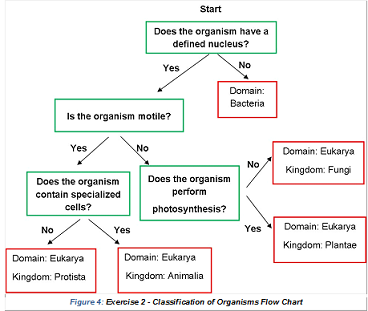Reference no: EM131103704
UMUC Biology 102/103 Lab 6: Taxonomy
Pre-Lab Questions-
1. Use the following classifications to determine which organism is least related out of the three. Explain your rationale.
|
Table 2: Classifications
|
|
|
Classification Level
|
American Green Tree Frog
|
European Fire- Bellied Toad
|
Eastern Newt
|
|
Domain
|
Eukarya
|
Eukarya
|
Eukarya
|
|
Kingdom
|
Animalia
|
Animalia
|
Animalia
|
|
Phylum
|
Chordata
|
Chordata
|
Chordata
|
|
Class
|
Amphibia
|
Amphibia
|
Amphibia
|
|
Order
|
Anura
|
Anura
|
Caudata
|
|
Family
|
Hylidae
|
Bombinatoridae
|
Salamandridae
|
|
Genus
|
Tursipops
|
Bombina
|
Notophthalmus
|
|
Species
|
cinerea
|
bombina
|
viridescens
|
|
|
|
|
|
|
|
2. How has DNA sequencing affected the science of classifying organisms?
3. You are on vacation and see an organism that you do not recognize. Discuss what possible steps you can take to classify it.
Exercise 1: Dichotomous Key Practice
|
Table 3: Dichotomous Key Results
|
|
Organism
|
Binomial Name
|
|
i
|
|
|
ii
|
|
|
iii
|
|
|
iv
|
|
|
v
|
|
|
vi
|
|
|
vii
|
|
|
viii
|
|
|
ix
|
|
|
x
|
|
|
xi
|
|
|
xii
|
|
|
xiii
|
|
Post-Lab Questions
1. What do you notice about the options of each step as they go from number one up?
2. How does your answer from Question 1 relate to the Linnaean classification system?
Exercise 2: Classification of Organisms
Data Tables and Post-Lab Assessment
Table 2: Key Characteristics of Some Organisms
|
Organism
|
Kingdom
|
Domain
|
Defined Nucleus
|
Motile
|
Cell Wall
|
Photosynthesis
|
Unicellular
|
|
E. coli
|
|
|
|
|
Yes
|
|
Yes
|
|
Protozoa
|
|
|
Yes
|
Yes
|
|
|
Yes
|
|
Mushroom
|
|
|
Yes
|
|
Yes
|
|
|
|
Sunflower
|
|
|
Yes
|
|
Yes
|
Yes
|
|
|
Bear
|
|
|
Yes
|
Yes
|
|
|
|

Post-Lab Questions
1. Did this series of questions correctly organize each organism? Why or why not?
2. What additional questions would you ask to further categorize the items within the kingdoms (Hint: think about other organisms in each of the kingdoms and what makes them different than the examples used here)?
3. What questions would you have asked instead of the ones that you answered above when classifying the organisms?
|
Calculate energies of the lowest three non-degenerate states
: Calculate the energies of the lowest three non-degenerate states for an electron moving in a 2-D crystal of edge length L = 0.5 x 10-10 m. Find the ratio of the reflected wave coefficient to the incident wave coefficient.
|
|
Cost planning on gasoline prices
: In June 2008, when gasoline prices were at an all-time high, greater than $4 per gallon, Chrysler Motor Company promoted its Jeep vehicle with the offer of either $4,500 off the price of the vehicle or the guarantee that the buyer would not pay mo..
|
|
Resulting strategic responses to new stage
: The U.S. Healthcare system is currently in a stage where consumer choices are re-shaping health care. What are the resulting strategic responses to this new stage? Do you work for an organization that is responding in any of these ways? Explain..
|
|
Explain how the position is related to the biological
: Explain how the position is related to the biological and/or physiological development as well as psychological development of adolescent girls. Further, explain how such findings can inform evidence-based social work practice.
|
|
How has dna sequencing affected the science
: How has DNA sequencing affected the science of classifying organisms? You are on vacation and see an organism that you do not recognize. Discuss what possible steps you can take to classify it
|
|
Evaluate theoretical perspective on which the study is based
: Detail the hypotheses presented in the study or the relationship of interest and Describe the sample(s) presented in the study (how participants were obtained, selected, sample size, etc.)
|
|
Electronics and communications engineering project
: Write specification for electronics and communications engineering project - Establishing the scope and parameters of the projects.
|
|
Describe data collection method including who collected data
: Describe the findings reported in the study. What is the answer to the research question based on these findings? If the study fails to answer the research question, what do you believe is the reason?
|
|
What is the formula for total costs of particular service
: What is the formula for total costs of a particular service or system? Relate this formula to the management of medical systems, providing at least two specific examples of applications
|